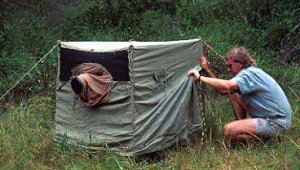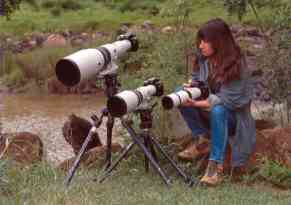Bird Photography - the Hardware
 It is often said that bird photography is the most difficult field of nature photography. Certainly compared with photographing game in reserves where they are habituated to vehicles, then bird photography may seem a tough proposition. Most of us, after buying our first telephoto lens, are dismayed to find that birds almost invariably fly away before you can get close enough for a picture! It is often said that bird photography is the most difficult field of nature photography. Certainly compared with photographing game in reserves where they are habituated to vehicles, then bird photography may seem a tough proposition. Most of us, after buying our first telephoto lens, are dismayed to find that birds almost invariably fly away before you can get close enough for a picture!
Bird photography is primarily about technique. There are numerous tricks of the trade that can make bird photography very productive indeed. In fact, I find that often I take more worthwhile bird pictures in a day than animal pictures during a game drive. In subsequent features, I will be discussing some of these techniques but a logical place to start this series would be to look at hardware first and in particular telephoto lenses. The ultimate lens for bird photography is probably a 600mm F4. At 600mm you get an impressive 12x magnification. The "fast" F4 aperture gathers enough light to shoot action with a 100ASA fine grained film. However, this is a huge piece of equipment weighing 6 kilos or more and unfortunately carries an equally hefty price tag - at local prices equivalent to a perfectly acceptable new car! Apart from the very wealthy or a person intending to make a living from photography, I think few could justify this kind of expenditure. I have certainly never been in the very wealthy category (and as a wildlife photographer equally certainly never will be!) and had to wait almost ten years before I could save enough to part pay for a 600mm F4. I borrowed the rest and repayments kept me poor for the following three years. Fortunately there have been some remarkable advances in optical technology in recent years. This means it is now possible to get quality super telephoto magnification at a fraction of the cost of a hefty 600mm F4. Teleconverters - also known as tele-extenders - are an additional series of optics placed between the lens and camera to increase magnification. Until a few years ago these were regarded as a very poor substitute for a big prime lens. So much sharpness was lost along with contrast and colour saturation that few serious photographers would want one in their camera bag. Today most of the main camera manufacturers are producing teleconverters matched to their tele lenses of such superb quality that it is difficult to tell if a teleconverter has been used. If you start with a 300mm F2.8 lens and add a 2x converter, the combination effectively becomes a 600mm F5.6 lens. At F5.6 it still has enough light gathering power to shoot action.  My wife and I photograph together and sometimes shoot the same subjects using a 600mm F4 and the 300mm F2.8 with 2x converter. I must admit I always commandeer the 600mm F4! When we have our films processed, there is often some dispute over who took which pictures. The 300mm F2.8 and converter costs less than half of the 600mm F4 and yet the results are virtually indestinguishable. I know of several photographers getting a lot of work published with this outfit including Warwick Tarboton whose superb portfolio was published in the first edition of "Africa - Birds and Birding". My wife and I photograph together and sometimes shoot the same subjects using a 600mm F4 and the 300mm F2.8 with 2x converter. I must admit I always commandeer the 600mm F4! When we have our films processed, there is often some dispute over who took which pictures. The 300mm F2.8 and converter costs less than half of the 600mm F4 and yet the results are virtually indestinguishable. I know of several photographers getting a lot of work published with this outfit including Warwick Tarboton whose superb portfolio was published in the first edition of "Africa - Birds and Birding".
Moving along in the affordability stakes, a slower 300mm can be combined with a teleconverter. If you add a 1.4x converter to a 300mm F4 lens, it becomes a 420mm F5.6. The 5.6 aperture is nice and fast and although not quite as powerful as the 600mm, the magnification is still a useful 8x, comparable to a good pair of binoculars. An added advantage is that this is a lightweight portable outfit that can be easily carried all day. An excellent choice for anyone wishing to combine some serious photography with serious birding! The cost should be less than one eighth of the 600mm F4 lens. It is possible to put a 2x converter on a 300mm F4 but the two stop light loss from the converter makes the combination a 600mm F8 which is a bit slow for anything other than static portraits. If you buy new or at least latest technology equipment made by a prime camera manufacturer, this ouftit will also give outstanding results. Autofocus is a topic I would like to discuss at length in a later feature. However, with so many keen photographers changing to autofocus, it means that there are a lot of perfectly good manual focus lenses on the second hand market. These could be a worthwhile option for those on a tight budget but always insist on testing a second hand lens thoroughly before purchase. It might look OK but a bad knock may have upset the alignment of internal optics. Remember also that very old equipment will have old technology and so may not work well with a teleconverter which is our "cheap" way of getting super-magnification. For supermagnification at a real budget price, you should look at a second hand Novaflex. Once the mainstay of many wildlife photographers, the Novaflex, which incidentally is a long focus lens rather than a true telephoto, has been somewhat overtaken by the new generation optics. There are many perfectly servicable second hand Novaflexes on the market and in the right hands can still produce very acceptable results. In fact, I know of quite a few photographs published in this magazine that were taken on a Noveflex. The last word on lenses is that if you are at all serious about bird photography or think you may become so in the future, always buy the best you can afford. Otherwise you are pretty sure to want to upgrade in the future. I have done a lot of buying and selling of lenses in the past and, goodness knows, it can become an expensive business! Top | Next | Tips Home | Stock Images | Books | Tips | Gallery | FAQ's | Kruger Park | Contact Text and photographs © Nigel Dennis |